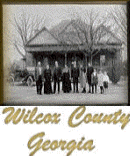|
Article describes the reaction of Dave Fitzgerald to the changes and
people of Abbeville, early pioneers and enterprises.
Surnames: Baker, Cannon, Cook, Davis, Fitzgerald, Keen, Keene,
McDuffie, Roberts, Statham, Wheat, Wilkinson |
ABBEVILLE - Dave
Fitzgerald was a Wilcox county pioneer whose thinking would fit in very
well with those of the return-to-the-land persuasion today. He had no
patience with what his neighbors were calling "progress". It made him
downright nervous.
As the owner of vast acreages in newly formed Wilcox
County, Fitzgerald, before 1860, had given to the county authorities 50
acres of land on which to locate a county seat. A wooden courthouse was
erected and dwellings and shops started to spring up. People began to
talk about Abbeville, which was named for Abba, the wife of the county
organizer, Norman McDuffie, becoming a flourishing "city" of a thousand
souls!
Fitzgerald was appalled at this circumstance of his own
making. According to an account printed in "Our Heritage" (1975) a
paperback collection of Wilcox county lore compiled by Reuviel Newman
Roberts and Lula Keen Cook, " Fitzgerald was a man of the forest,
desiring only land to graze his cattle and log cabins to house his
people. The idea of cultivating land and growing cotton did not 'run up
his ally.' This was too much work. All he wanted was a pony to ride on
after his cattle and a shade to drowse under while watched his herds.
Visualizing Abbeville's growth with horror, he sold his lands in that
area and moved to the Western part of the country where he could graze
his thousands of cattles on thousands of acres of forest land without
being bothered with courthouses and people who wanted to build a
'city.' And so, the man who gave so generously of land on which to build
Abbeville disappeared quietly from public view." The interesting little
saga was written by the late Corinne Wilkinson.
As the Bicentennial approaches more and more small
towns are taking a look back at their beginnings, but Wilcox county and
Abbeville started its observance three years ago with Heritage Day
celebrations, including the performance of a pageant written for the
occasion by Gladys D. Cannon. This year's festival was held on May 10.
Older citizens must have
looked between the pages of family Bibles, in yellowing newspaper files
and among the records of onetime Confederate soldiers for the anecdotes
printed in "Our Heritage." Samples include: the late Josiah Keene, aged
16, who was on his way to the mill with corn when a group of Yankee
soldiers stopped him to ask if he had seen the escaping Jefferson
Davis... T.H. Wheat, who fired the first shot on Fort Sumter, moving
from Floyd to Wilcox county and relating how he went unscathed
throughout the War, his only wound occurring from a falling brick during
a bombardment... how Abbeville looked in 1917, the iceman, millinery
shop, soda fount, blacksmith shop and mill, written by Irene Cannon
Warren... memories of a move by train and mule-wagon from Alabama to
Wilcox county, by William Marvin Baker Sr. ... "Uncle Norman and Aunt
Molly," a sensitive portrait of an old black couple of genteel
dignity... turpentine still...steamboat days ... church records.
More absorbing than many a "historical" novel is the
portrait included of Norman Statham, who died nearby Rochelle in 1933 at
the age of 107, having fought Indians and Yankees, been a woodsman,
riverman and soldier of fortune.
It was Statham, who is 1878, contracted with an
emissary of Germany's Bismarck to provide 100 pine masts, 107 feet tall,
from Georgia pine forests. He cut the timber, floated it down the river
to Darien, saw in aboard a German navy vessel, put $10,000 in his
pocket, and accompanied by one of his black woodsmen, walked back home.
In 1888 he furnished 40 masts of similar stature to the French navy.
Good timber was getting scarce and only an experienced woodsman could
find that many virgin pines, even then.
When a sawmill company wanted to move two large
stationary boilers and found the existing roads too soft, Statham
offered to move them for $250. He plugged the holes in the boilers and
ROLLED them to the river bank. Then, as the whole county gathered along
the banks of the Ocmulgee to hoot at his mad plan, the boilers floated
easily off and were towed to their point of destination.
Interesting to old
house buffs is the relation by Dr. Leadford Williams (named for his
father's prized cap and ball Leadford rifle) of how a landowner went
about building a farm house before the War.
"It took three years
to prepare the timbers. My old father went out into his forest and
felled straight, beautiful white oak tress and with his own hands, and
only a poll and broad ax and a marking line, hewed and shapped the
silly. Then he cut and shaped pines, six by eight, proper length, for
his corners, door and window posts and his plates. He and his sons
dammed up the branch and erected a sawmill on which the sawed out all
the boards needed for flooring, weatherboarding and ceiling ... he had
his own blacksmith shop and a man making all the cut nails needed to
nail on the boards ... in the framing they used not a single nail ...
they opened a rock quarry and quarried out the granite needed for the
pillars and chimneys... The only store-bought material this this old arm
home was the window panes, the locks and the doors hinges ..." |

